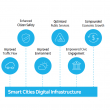
Wilf Pinfold is CEO of Urban.Systems
In this video, Wilf Pinfold from Urban.Systems describes the Smart Cities Emerging Interest Group, a new addition to ACM.
What is a Smart City? The way we like to think about it is that bringing technology to make a city more livable, more workable, more enjoyable to live in, it starts to qualify as smart city. Now there are a lot of ways in which can do this. Some of which we know. Some of which we don’t know. But what we’re trying to do is we’re trying to identify all the ways in which technology can make a city better and catalog and categorize those and allow other cities to see how cities are doing it.”
insideSmartCities: So how did this get started?
Wilf Pinfold: So I think you’re aware of the Global City Teams Challenge work that we’ve been doing working with National Institute of Standards and Technology, and we have a very specific mission to try and identify places where technology has been used and then make it available, make the knowledge about that available to other cities so as they can follow along. So any city that’s doing something smart with technology, starts to categorize as a smart city.
insideSmartCities: So let me ask you about the overlap with HPC. SC17 is a Supercomputing conference. What’s the connection?
Wilf Pinfold: So there are a number of people who are part of the community and Charlie Catlett, who’s giving the plenary session this afternoon, is one of those people that have been looking for ways to use high performance computing, or technology behind high performance computing, to make the city better.
If you think about what the city looks like, there are processors all over it, right? We’re going to have sensors in many places, things that tell us what the air quality is, things that tell us where the traffic is, and those sensors need to be able to provide us with information, not just streams of data. And if you have all those sensors all over the city, the amount of data that’s coming off them is way too large for anybody to even move around the city. So you need to start to push processing towards the edge. You need to be able to have a sort of staging event data. Along a street you may have cameras that are telling you what traffic spots are open. They can be aggregated at some junction point, and that can give information back to a control center that puts information into an application that I can look up and say, “Oh, look. There’s three spots over here. I’m going to go park over here.” That staging of all of that data, you can think about it as a distributed parallel task. A lot of the technologies that have been developed in the high performance computing community could be repurposed into that space, and I think that’s a really interesting overlap between the two.
Further, once you get back to that control center, in many cases, those are pretty substantial computing facilities of their own. A lot of opportunity for analytics to be done there. So there’s an overlap here. It’s certainly not one and one. I would expect that at the plenary today there’ll be– majority of people there will be high performance computing people and they’ll go off and do high performance computing beyond that.
There’ll be some set of people who are really interested in smart cities, and we’re working on trying to put together through ACM a community of those people, people who are looking at the technology in the city. But this was a really good place given that Charlie Catlett is doing the plenary here to sort of make sure that the people in the high performance computing community are aware of what’s going on, and they have an opportunity to link to another community that’s going to go off and look at these smart cities.
insideSmartCities: I wanted to ask you about that. The ACM just made an announcement about Smart Cities. There’s kind of an interest group forming, isn’t there?
Wilf Pinfold: Well, that’s really interesting. So everybody’s aware of the ACM SIG structure, the Special Interest Groups, and of course, the conference here is under SIGHPC, and then people know about SIGGRAPH. There are a number of SIGs out there. ACM has been looking for a way to get new and developing communities started. So they’ve come up with this idea of an Emerging Interest Group, an EIG, and that’s something that’s starting this year. We will, in fact, be the first.
And you can go to the ACM site and look up Emerging Interest Groups. It’ll show you the structure of what an Emerging Interest Group is, and it’ll give you a link to the Smart Connected Communities Emerging Interest Group, which is the group that we’re setting up, and it’ll even give you a join link there so you can join. And we’re hoping that by the time we get to the plenary today, there’ll be a Smart Connected Community, so scc.acm.org, which is a website that you’ll be able to go to to get all this stuff. And I’m hoping we will be streaming the plenary thanks to work that you’re doing. So thank you very much.
insideSmartCities: Yeah. I’m really excited about that. It’s going to be a great session.
Wilf Pinfold: I am too. I think it’ll be great. Yeah.
insideSmartCities: Well, Wilf, thanks for coming and good luck with the smart cities initiatives.



Leave a Comment